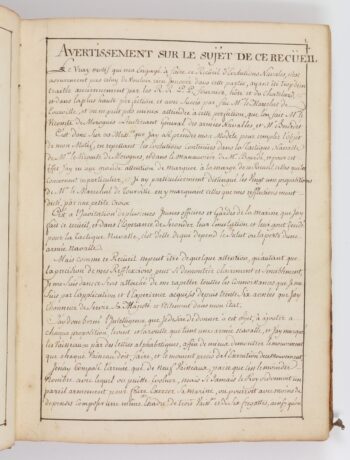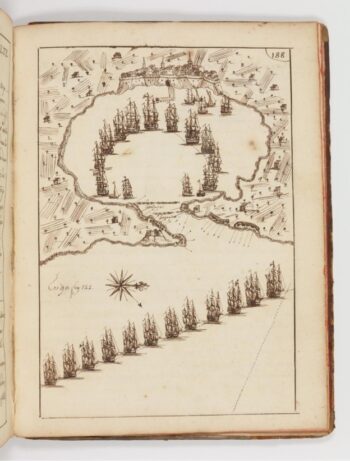Elegant and carefully composed, this unpublished manuscript reflects the intellectual and professional rigor of eighteenth-century naval education. The manuscript Évolutions navales is an anonymous French officer’s synthesis of tactical principles and fleet maneuvers, a lifetime’s experience distilled for the next generation of sailors and commanders. Purchased in September 2025, the manuscript strengthens the American Revolution Institute’s collections documenting the international dimensions of the American Revolution. French naval support was essential to American independence, and the training that made that success possible depended on technical and theoretical works like this one. Few manuscripts survive that reveal how eighteenth-century officers learned to think at sea. This volume is therefore a rare and revealing witness to the intellectual preparation behind France’s decisive naval victories and a material link between European military science and the triumph of the American cause.
 In his preface, “Avertissement sur le sujet de ce recueil,” the author explains that he prepared the volume at the request of younger officers and sailors, drawing on thirty-six years of service at sea. The manuscript’s finely executed pen-and-ink diagrams illustrate fleet and battle formations, signaling systems and maneuvers both on the open ocean and in coastal waters. A detailed “Table des évolutions contenues dans ce recueil” concludes the volume, confirming that it was intended as a teaching manual.
In his preface, “Avertissement sur le sujet de ce recueil,” the author explains that he prepared the volume at the request of younger officers and sailors, drawing on thirty-six years of service at sea. The manuscript’s finely executed pen-and-ink diagrams illustrate fleet and battle formations, signaling systems and maneuvers both on the open ocean and in coastal waters. A detailed “Table des évolutions contenues dans ce recueil” concludes the volume, confirming that it was intended as a teaching manual.
This singular work exists only in manuscript form and represents the education of a French naval officer in the decades before the American Revolution. Drawing upon great authorities of the French naval tradition, including Tourville (1693), Hoste (1697), Morogues (1763) and Bourdé de Villehuet (1765), the author synthesized the tactical canon of his age into one accessible compendium. These masters of the naval art of war codified the science of fleet maneuver, signaling and disciplined coordination that transformed seamanship into a true military profession. Marginal notes cite these sources precisely, allowing scholars to trace how eighteenth-century officers digested, excerpted and re-presented printed works for instruction and operational use. Viewed through the lens of book history and bibliography, the manuscript also illuminates how material texts—copied, annotated and adapted by hand—functioned as practical instruments of learning and command within the naval world. The result is a window into the pedagogical culture of the French navy during a crucial period of reform and renewal following the Seven Years’ War.
The Évolutions navales manuscript also reflects a broader historical transformation. After the devastating losses of the Seven Years’ War, France launched an ambitious program to rebuild its fleet and reassert its maritime power. Naval academies were reformed, dockyards expanded and new manuals standardized tactics and signaling. This renewed emphasis on professional training would bear fruit two decades later, when French naval forces became indispensable allies to the Americans in their struggle for independence.
 The American Revolution included engagements between the world’s two greatest naval powers, Britain and France, in a maritime conflict of unprecedented scale. Together, their fleets deployed more than 1,200 warships, 25,000 naval guns and over 300,000 sailors across the globe. At the Battle of the Chesapeake in 1781, the fleet commanded by Admiral de Grasse wielded a concentration of firepower that eclipsed the combined armies of Washington and Rochambeau on land. “Without a decisive naval force we can do nothing definitive,” Washington wrote to Lafayette, “and with it, everything honorable and glorious.”
The American Revolution included engagements between the world’s two greatest naval powers, Britain and France, in a maritime conflict of unprecedented scale. Together, their fleets deployed more than 1,200 warships, 25,000 naval guns and over 300,000 sailors across the globe. At the Battle of the Chesapeake in 1781, the fleet commanded by Admiral de Grasse wielded a concentration of firepower that eclipsed the combined armies of Washington and Rochambeau on land. “Without a decisive naval force we can do nothing definitive,” Washington wrote to Lafayette, “and with it, everything honorable and glorious.”
The officers who founded the Society of the Cincinnati were successful practitioners of eighteenth-century warfare. Many were self-taught professionals whose mastery of the military arts came as much from study as from battle. The Évolutions navales manuscript embodies that pursuit of the art of war, revealing how knowledge was refined through experience, preserved through disciplined study and transmitted to those who would lead in the field and at sea. As a rare synthesis of theory and practice, it offers scholars a foundation for advanced study of how the French navy prepared, trained and ultimately achieved the maritime power that made American independence possible.
Thomas G. Lannon
Library Director